|
|
|
This page contains the following further information for opportunities:
|
|
GLOSSARY
Business
A business is defined as 'a legal entity engaging in productive activity and/or other forms of economic activity in the market sector'. Such entities accumulate assets on their own account and/or hold assets on behalf of others, and may incur liabilities. Excluded are the economic activities of individuals (except where individuals engage in productive activity either as sole traders or in partnership) and entities mainly engaged in hobby activities'. For more information on the ABS definition of a business, users should refer to Information Paper: A Statistical View of Counts of Businesses in Australia (cat. no. 8162.0).
Business Entry
A business which has newly registered for an ABN and which has a GST role allocated. Business entry rates are calculated by taking the total business entries during a financial year divided by the total businesses operating at the start of the financial year, multiplied by 100.
Employed
People aged 15 years and over who, during the reference week:
- worked for one hour or more for pay, profit, commission or payment in kind in a job or business, or on a farm (comprising employees, employers and own account workers); or
- worked for one hour or more without pay in a family business or on a farm (i.e. contributing family workers); or
- were employees who had a job but were not at work and were:
- away from work for less than four weeks up to the end of the reference week; or
- away from work for more than four weeks up to the end of the reference week and received pay for some or all of the four week period to the end of the reference week; or
- away from work as a standard work or shift arrangement; or
- on strike or locked out; or
- on workers' compensation and expected to return to their job; or
- were employers or own account workers who had a job, business or farm, but were not at work.
Estimated resident population (ERP)
The estimated resident population (ERP) is the official measure of the population of Australia. It is based on the concept of usual residence. For the purpose of ERP, a person is regarded as a usual resident if they have been (or are expected to be) residing in Australia for a period of 12 months or more. As such, it refers to all people, regardless of nationality, citizenship or legal status who usually live in Australia, with the exception of foreign diplomatic personnel and their families.
Labour force
For any group, persons who were employed or unemployed, as defined.
Level of education
Level of education is a function of the quality and quantity of learning involved in an educational activity. It is categorised according to the Australian Standard Classification of Education, 2001 (cat. no. 1272.0) Level of education classification.
Non-school qualification
Non-school qualifications are awarded for educational attainments other than those of pre-primary, primary or secondary education. They include qualifications at the Postgraduate Degree level, Master Degree level, Graduate Diploma and Graduate Certificate level, Bachelor Degree level, Advanced Diploma and Diploma level, and Certificates I, II, III and IV levels. Non-school qualifications may be attained concurrently with school qualifications.
Persons in the labour force
People who were classified as being in the labour force, that is, either employed or unemployed.
Persons not in the labour force
People who were not in the categories 'employed' or 'unemployed' as defined.
Real net national disposable income (RNNDI)
Calculated by:
- taking real gross domestic income;
- deducting real incomes payable to the rest of the world;
- adding real incomes receivable from the rest of the world; and
- deducting the volume measure of consumption of fixed capital.
Real incomes payable and receivable are calculated by dividing the nominal income flows by the implicit price deflator for gross national expenditure. In the derivation of the aggregate, all of the adjustments are made using the chain volume aggregation method used to derive all of the ABS chain volume estimates.
Real net national disposable income (RNNDI) per capita
The ratio of RNNDI to the estimated resident population (ERP) of Australia. Population estimates use data published in the quarterly publication ABS Australian Demographic Statistics (cat. no. 3101.0). See 'Real net national disposable income (RNNDI)'.
Skill level of occupation
Skill level is defined as a function of the range and complexity of the set of tasks performed in a particular occupation. The greater the range and complexity of the set of tasks, the greater the skill level of an occupation.
Skill level is measured operationally by:
Unemployed
People aged 15 years and over who were not employed during the reference week, and:
- had actively looked for full-time or part-time work at any time in the four weeks up to the end of the reference week and were available for work in the reference week; or
- were waiting to start a new job within four weeks from the end of the reference week and could have started in the reference week if the job had been available then.
Wanted to work
People not in the labour force who were not actively looking for work who answered 'yes' or 'maybe' when asked if they would like a job, as well as those people not in the labour force who were actively looking. It is assumed those people actively looking want a job.
|
|
There are no references for this theme
|
Click on the links below to be taken to a summary of the graphs from the corresponding tab within the opportunities theme:
Overall progress?
Employment
Business
Standard of living
Capabilities
|
| OVERALL PROGRESS? |
 |
Persons with a Certificate III or above or employed in a skilled occupation(a) |
 |  |  |
 |  |  |
Headline progress indicator |  | ...by sex |
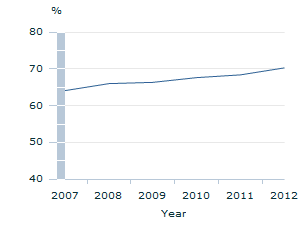
Footnote:
(a) Persons aged 20-64 years.
Source:
ABS data available on request, 2007-2012 Surveys of Education and Work |  | 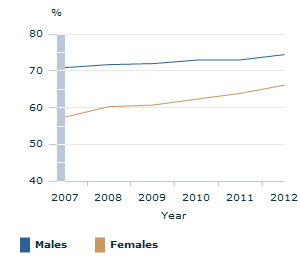
Footnote:
(a) Persons aged 20-64 years.
Source:
ABS data available on request, 2007-2012 Surveys of Education and Work |
 |  | |
|
| EMPLOYMENT |
 |
Employment as a proportion of people who are in work or want to work(a)(b) |
 |  |  |
 |  |  |
Progress indicator |  | ...by sex |
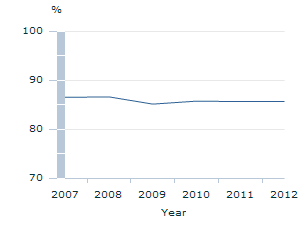
Footnote:
(a) Persons aged 15 years and over.
(b) Data is for September.
Source:
ABS data available on request, Persons Not in the Labour Force |  | 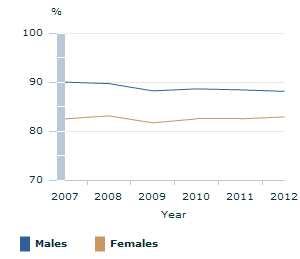
Footnote:
(a) Persons aged 15 years and over.
(b) Data is for September.
Source:
ABS data available on request, Persons Not in the Labour Force |
 |  |  |
 |  |  |
 |  |  |
...by state and territory |  |  |
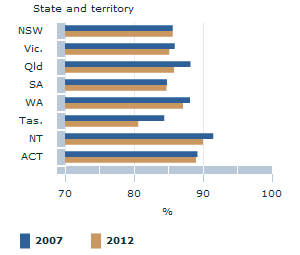
Footnote:
(a) Persons aged 15 years and over.
(b) Data is for September.
Source:
ABS data available on request, Persons Not in the Labour Force |  |  |
 |  | |
|
| BUSINESS |
 |
New business entry rate(a) |
 |  |  |
 |  |  |
Progress indicator(b) |  | ...by state and territory |
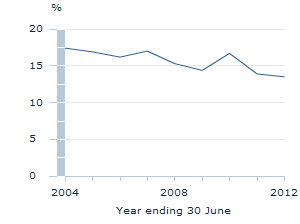
Footnote:
(a) Entries relative to total operating businesses at start of financial year.
(b) A spike evident in 2009-10 is due to a change in ABS methodology.
Source:
ABS Counts of Australian Businesses, Including Entries and Exits (cat. no. 8165.0) |  | 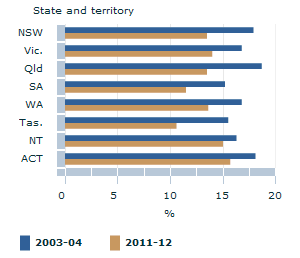
Footnote:
(a) Entries relative to total operating businesses at start of financial year.
Source:
ABS Counts of Australian Businesses, Including Entries and Exits (cat. no. 8165.0) |
 |  | |
|
| STANDARD OF LIVING |
 |  |  |
Real net national disposable income per capita(a) |
 |  |  |
 |  |  |
Progress indicator |  |  |
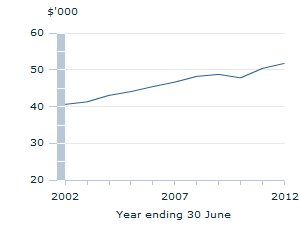
Footnote:
(a) Reference year is 2010-11.
Source:
ABS Australian System of National Accounts, 2011-12 (cat. no. 5204.0) |  |  |
 |  | |
|
| CAPABILITIES |
 |  |  |
Persons with a Certificate III or above or employed in a skilled occupation(a) |
 |  |  |
 |  |  |
Progress indicator |  | ...by sex |
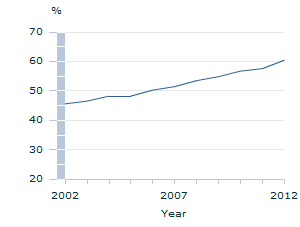
Footnote:
(a) Persons aged 25-64 years.
Source:
ABS data available on request, 2002-2012 Surveys of Education and Work |  | 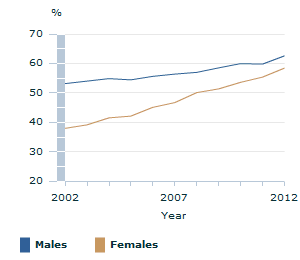
Footnote:
(a) Persons aged 25-64 years.
Source:
ABS data available on request, 2002-2012 Surveys of Education and Work |
 |  | |
|
|
|
|
